|
Story and Photos by Harald Zoschke
|
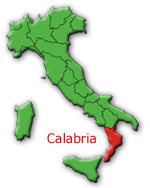
|
Calabria occupies the “boot tip” of the Italian peninsula south of Naples. The warm Mediterranean Sea that flows around Italy’s southern tip between Calabria and Sicily, as well as 300 estimated sunshine days per year, determine the mild climate that lets chile peppers prosper here. The hot pods – called peperoncini in Italy – are a staple of Calabrian cuisine. In fact, they’re important enough to have their own annual festival at peak harvest time in September.
|
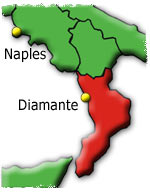
|
|
The place of that event and center of the southern Italian peperoncino cult is Diamante at the Costa dei Cedri, a pleasantly undeveloped part of Italy’s west coast with its clear sparkling seas.
The historical fishermen’s village is situated on a rock, safe from flooding, and – in ancient times – from pirates, too. Today, tourists capture the town instead – thousands of them in the summer, many from northern Italy, but also from other parts of Europe. By early September, most of them are gone – except for the chileheads, that is. They’re here for their event of the year, the Festival del Peperoncino. In 2002 it took place for the 10th time, from September 4 to 8.
|
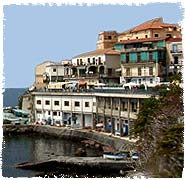
|
Renate and I arrived two days early. That way, we had some time on our hands to explore Diamante and find our way around town before the festival started. We flew into Naples, about 3.5 driving hours north of our destination. We picked up a rental car, and heading south, just outside Naples, the impressive Vesuvius can be seen. There’s an exit to Pompei, the city buried by lava when the volcano erupted in 79 AD. A little off-topic, but for some amazing Vesuvius pics and facts, check this site. Last time the mountain spit fire was 1944 — we’re getting closer to spitting fire ourselves. The drive on State Street 18 was quite adventurous. Locals down there are pretty much laid-back, but once they’re behind the wheel, they seem to drive for their lives. No-passing zones and speed limits seem to be regarded as mere recommendations that nobody but tourists from out of town is taking seriously, despite hefty fines.
Well, we made it safely late at night to Hotel Christina, which we booked from a travel catalog. Catalog description and reality turned out to be too different to stay there, so next day we moved to Hotel dei Focesi, closer to Diamante, and closer to the beach.
|

|
Looking north from Diamante:
The beautiful beach and clear sparkling sea
In the background, you’ll find the
Hotel dei Focesi nearby (arrow), which
even has a private beach.
For our 2004 Hotel update, check here
|
The close proximity to the village enabled us to leave the car in the hotel parking lot and use the nice boardwalk along the beach promenade with its beautiful palm trees. Good shoes are recommended, as Diamante is built on a rock. The streets are a maze of narrow up- and downhill lanes with many, many stairs. But each of the stairs leads to interesting scenes.
|
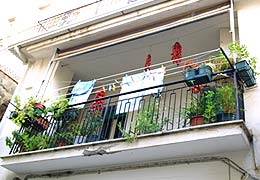
|
And it is those stairs and narrow alleys that contribute much to the charm of this village, which seems somewhat weathered by the sea climate but very tidy. Century-old stucco facades, playful little stairways und bold balconies catch the eye, and the well-filled clothes lines stretching over those balconies are an unmistakable sign that you’re in an Italian village. At this time of the year, August/September, those lines also a dead giveaway that you’re in one of Europe’s chile pepper centers — there’s not just laundry drying in the mild late summer air, but strings of pods as well. Everywhere!
|
|
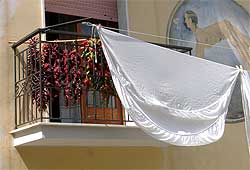
|
In August/September, it’s
hard to find a balcony in
Diamante without strings of
peperoncini drying in this
mild climate.
Ah, chile-flavored linen!
|
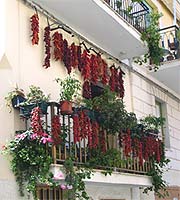
|
|
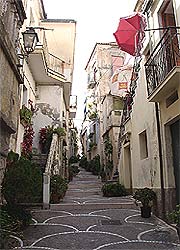
|
Sure, this isn’t Venice, but there are also cultural treasures Diamante has to offer, and without visiting a museum , you can enjoy them for free. The village is famous for its artful murals (murales), which make exploring all those alleys even more fascinating.
Often those alleys are so narrow that you have to curl your toes to let a car pass by. No later than now you realize why Italians prefer scooters and smaller cars.
|
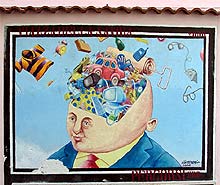
Original wall paintings (murales)
can be found everywhere in Diamante.
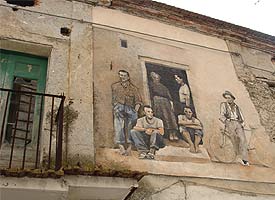
|
|
One mural has a scene of men, standing around, killing time. Calabria has seen rough times in history, and in the 20th century, about a third of its population left, many emigrating to the United States.
Therefore it is no wonder that there are Web sites around like Our Calabrian Heritage, which links to even more Calabrian sites
Quite a few Calabrians returned, though, and many again appreciate the region’s enormous natural beauty and treasures. Tourism just started to take off, and agriculture is blooming in this blessed climate, including a multitude of peperoncino varieties specific to this area.
|
|
At one house in a street named Via Crispi we discover a chile-decorated sign that reads “Peperoncino House da 1630” – a clue about the early arrival of the hot pods in southern Italy. Those were the days when a network of spice and silk routes developed across much of Asia and Europe.
|
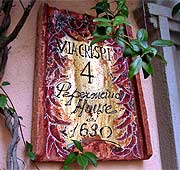
|
|
The Chile Festival is close …
To celebrate the 10th anniversary of the Peperoncino Festival, the Italian postal service issued a commemorative postmark. A beautiful stamp, showing the Diamante seaside and a bunch of chiles was already issued in 2001.
|

|
|

A village infected by peperoncino-fever
|
Banners across the streets announce the fiery event.
All of a sudden we’re standing in front of a peperoncino which doesn’t deserve the ending “…ino” (peperoncino means “small peperone“).
The 20 feet tall pod indicates that we can expect big things to happen during the coming days.
|
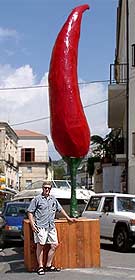
|
|
At this time of the year, Diamante is breathing peperoncini, and with the festival coming closer, there’s hardly a business in town without a chile-decorated storefront. Like in this clothes store, the hod pods are everywhere.
Especially for the festival, a hair stylist created a peperoncino style, demonstrated on a rotating head in front of her store.
Miss Peperoncino 2000, discovered on a festival poster, is living proof enough that this style can actually look pretty sharp!
|
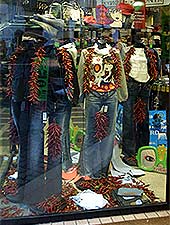
|
|
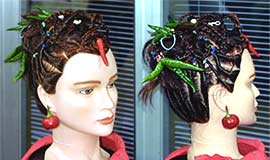
Mary Jane should wear this at the next Fiery Foods Show.
|
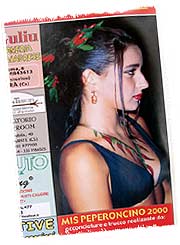
|
|

|
The same poster also shows pepper-decorated versions of the Smart, a trendy European sub-compact car which is highly energy efficient. You could win this car in a raffle at the festival. We weren’t the lucky ones, but Renate and I wondered how much we would have enjoyed the 1500 mile ride back home if we had won this cutie 
The background, by the way, shows Isola di Cirella, a small uninhabited island just half a mile off the coast.
|
|
At a jeweler store we discovered jewelry made from metal parts and fresh chile. We asked ourselves what the beautiful necklaces would look like after the pods dried. Anyway, nice idea.
Only in Diamante: A hibiscus plant at a street café, sporting not only flowers but chile pods as well. Does Paul Bosland know about this “hot” hybrid? Capsicum hibiscusiense?
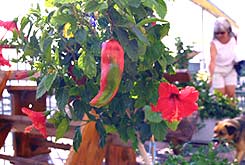
|
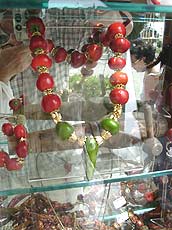
|
|
Everyday life is also influenced by the area’s most popular spice and vegetable. While strolling through the alleys, we’re all of a sudden reminded of New Mexico – the delicious, highly addictive smell of freshly rosted peppers is in the air!
So we’re just following our noses, and eventually we disvover a woman, roasting pods on charcoal in a little bowl on her doorstep. Mama mia, wish we were invited here for lunch!
This really started our appetite for some peperoncino specialties, and we’re going to check out some “hot” restaurants in town. Stay tuned, as we’re going to tell you about our findings in our next report …
|
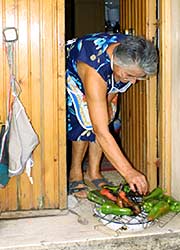 |
|


























